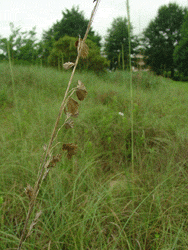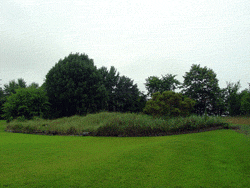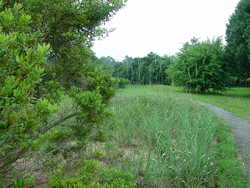Coastal Dune
 Dunes are vegetated sand ridges that form along sandy coasts where the forces of waves and wind are relatively strong, such as the northern coast of the Gulf of Mexico in Alabama and Florida. Plants have an important role in this process by trapping sand particles, which allow dunes to increase in height and width. The large dunes nearest to the shore are primary, or fore dunes. The coastal beach is a harsh environment for plants and animals. To survive there plants have developed special adaptations like large root systems, fast growth rates, low profiles, salt tolerance and prolific seed production. As these plants trap sand and organic debris, grasses like sea oats and beach panicum grass colonize the area continuing the process of dune formation by trapping more sand and stabilizing it with dense root systems. These plants can produce more stems and roots as the sand accumulates and the dune increases in size. These primary dunes are important for protection of the coast. They provide a buffer to protect inland areas from wave damage, saltwater intrusion and strong winds, allowing the development of more complex inland plant communities.
Dunes are vegetated sand ridges that form along sandy coasts where the forces of waves and wind are relatively strong, such as the northern coast of the Gulf of Mexico in Alabama and Florida. Plants have an important role in this process by trapping sand particles, which allow dunes to increase in height and width. The large dunes nearest to the shore are primary, or fore dunes. The coastal beach is a harsh environment for plants and animals. To survive there plants have developed special adaptations like large root systems, fast growth rates, low profiles, salt tolerance and prolific seed production. As these plants trap sand and organic debris, grasses like sea oats and beach panicum grass colonize the area continuing the process of dune formation by trapping more sand and stabilizing it with dense root systems. These plants can produce more stems and roots as the sand accumulates and the dune increases in size. These primary dunes are important for protection of the coast. They provide a buffer to protect inland areas from wave damage, saltwater intrusion and strong winds, allowing the development of more complex inland plant communities.
Our dune includes sea oats (Uniola paniculata), bitter panicum grass (Panicum amarum), minty rosemary (Conradina canescens) and others. The apex predator of our dune is the Eastern six -lined race runner (Cnemidophorus sexlineatus), which can be frequently seen hunting along the border between the dune and the lawn.


